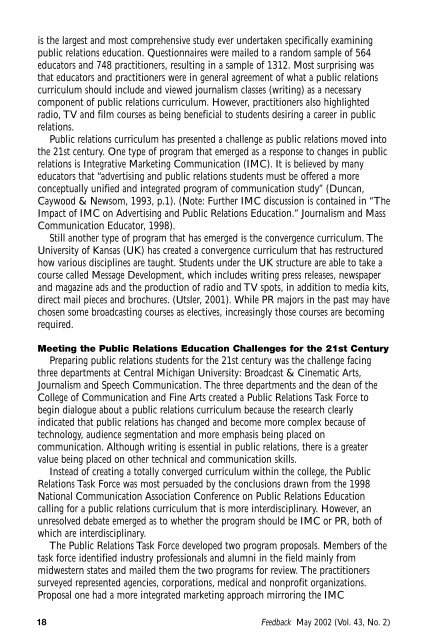Feedback May 2002 (Vol 43 No 2)
Feedback May 2002 (Vol. 43, No. 2) - Broadcast Education ...
Feedback May 2002 (Vol. 43, No. 2) - Broadcast Education ...
- No tags were found...
Create successful ePaper yourself
Turn your PDF publications into a flip-book with our unique Google optimized e-Paper software.
is the largest and most comprehensive study ever undertaken specifically examiningpublic relations education. Questionnaires were mailed to a random sample of 564educators and 748 practitioners, resulting in a sample of 1312. Most surprising wasthat educators and practitioners were in general agreement of what a public relationscurriculum should include and viewed journalism classes (writing) as a necessarycomponent of public relations curriculum. However, practitioners also highlightedradio, TV and film courses as being beneficial to students desiring a career in publicrelations.Public relations curriculum has presented a challenge as public relations moved intothe 21st century. One type of program that emerged as a response to changes in publicrelations is Integrative Marketing Communication (IMC). It is believed by manyeducators that “advertising and public relations students must be offered a moreconceptually unified and integrated program of communication study” (Duncan,Caywood & Newsom, 1993, p.1). (<strong>No</strong>te: Further IMC discussion is contained in “TheImpact of IMC on Advertising and Public Relations Education.” Journalism and MassCommunication Educator, 1998).Still another type of program that has emerged is the convergence curriculum. TheUniversity of Kansas (UK) has created a convergence curriculum that has restructuredhow various disciplines are taught. Students under the UK structure are able to take acourse called Message Development, which includes writing press releases, newspaperand magazine ads and the production of radio and TV spots, in addition to media kits,direct mail pieces and brochures. (Utsler, 2001). While PR majors in the past may havechosen some broadcasting courses as electives, increasingly those courses are becomingrequired.Meeting the Public Relations Education Challenges for the 21st CenturyPreparing public relations students for the 21st century was the challenge facingthree departments at Central Michigan University: Broadcast & Cinematic Arts,Journalism and Speech Communication. The three departments and the dean of theCollege of Communication and Fine Arts created a Public Relations Task Force tobegin dialogue about a public relations curriculum because the research clearlyindicated that public relations has changed and become more complex because oftechnology, audience segmentation and more emphasis being placed oncommunication. Although writing is essential in public relations, there is a greatervalue being placed on other technical and communication skills.Instead of creating a totally converged curriculum within the college, the PublicRelations Task Force was most persuaded by the conclusions drawn from the 1998National Communication Association Conference on Public Relations Educationcalling for a public relations curriculum that is more interdisciplinary. However, anunresolved debate emerged as to whether the program should be IMC or PR, both ofwhich are interdisciplinary.The Public Relations Task Force developed two program proposals. Members of thetask force identified industry professionals and alumni in the field mainly frommidwestern states and mailed them the two programs for review. The practitionerssurveyed represented agencies, corporations, medical and nonprofit organizations.Proposal one had a more integrated marketing approach mirroring the IMC18<strong>Feedback</strong> <strong>May</strong> <strong>2002</strong> (<strong>Vol</strong>. <strong>43</strong>, <strong>No</strong>. 2)
















